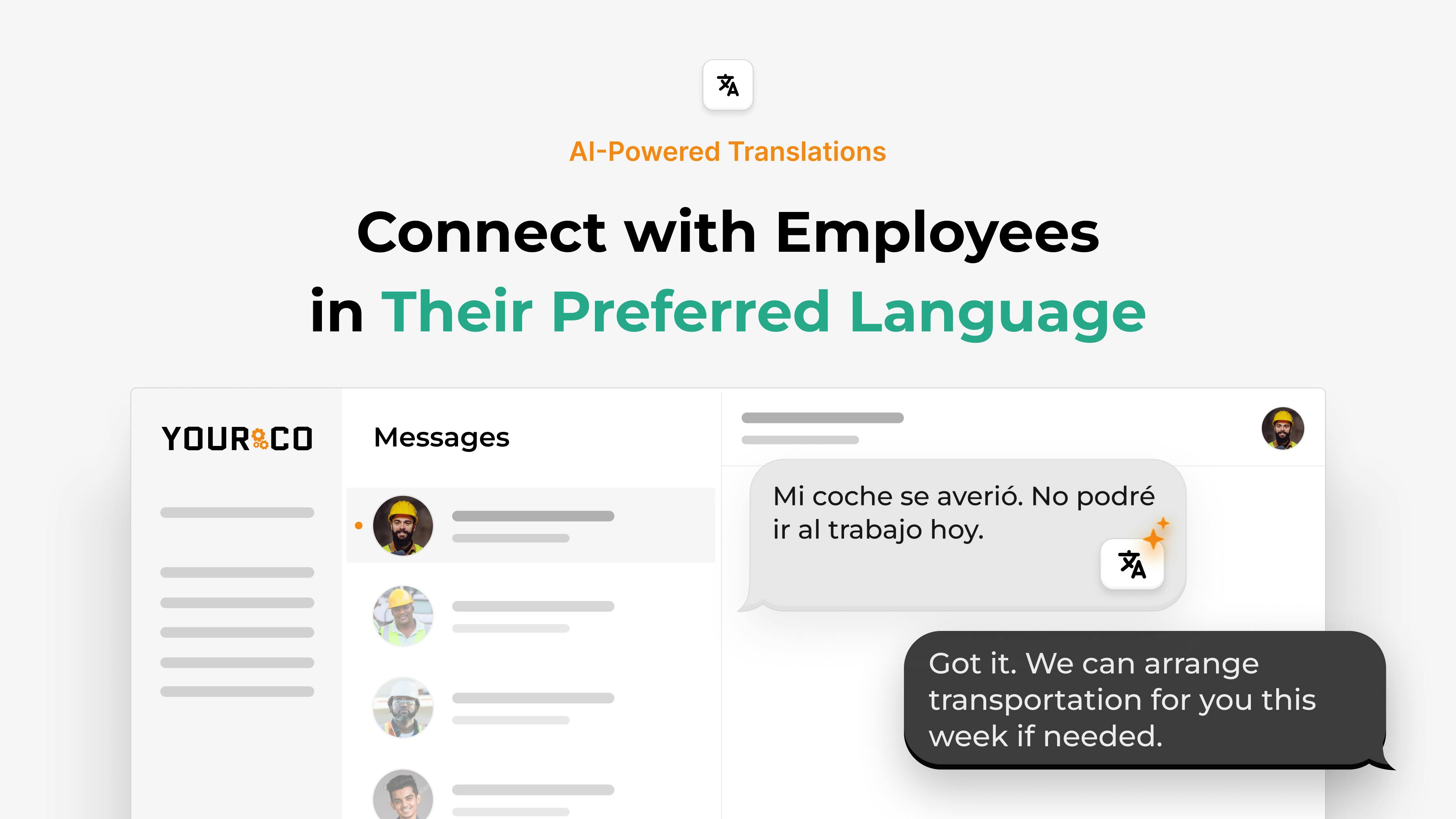How to Onboard Tagalog-Speaking Employees: An 8-Step Framework


Language barriers in the workplace can make non-native English speakers feel excluded, lead to misunderstandings of compliance requirements, and hinder their ability to reach full productivity.
A solid onboarding plan sets the tone for every new hire, and is especially important when your team includes non-English speakers. Without clear language access and cultural context, even the best policies get lost in translation. The resulting gaps can be safety issues, low engagement, and early turnover that can undo months of recruiting work.
When it comes to Tagalog-speaking employees, wrapping each touchpoint in cultural respect while offering safety instructions and daily communications in Tagalog can bridge these gaps. For example, honoring Filipino values such as pakikisama (harmony) and malasakit (care), you gain committed teammates who look out for each other and the business.
This guide outlines eight steps to onboarding Tagalog-speaking employees that are equally effective on a manufacturing floor as they are behind a desk.
1. Prepare Legally Compliant, Language-Accessible Paperwork
Proper documentation protects both your business and your new hire from day-one misunderstandings. When every form is complete and every clause is understood in Tagalog, you create a foundation for successful employment.
If you have Filipino workers, it’s a good idea to provide all training materials, onboarding documents, and handbooks in both English and Tagalog. Clear translations help employees understand probation terms, overtime rules, and safety obligations upfront, reducing the risk of claims that they "didn't know" what they were signing.
Make a list of every document a new hire will see, including:
- Safety manuals and procedures
- The employee handbook
- HR forms
- Compliance paperwork
Before you balk at the cost of translation services, remember that a clear Tagalog version of your policies can be decisive in a dispute over working conditions or benefits.
2. Send a Warm, Culturally Aware Welcome Before Day One
Pre-boarding is the first real expression of company culture. Sending details in Tagalog reinforces inclusion and minimizes misunderstandings. In practice, that means translating the essentials and keeping language friendly, personal, and respectful.
A short SMS might read: "Maligayang pagdating, Ana! Excited kaming makasama ka. Narito ang iyong first-day schedule. Kung may tanong ka, tawagan mo lang ako — nandito ako para tumulong." This greeting uses inclusive "kami" (we) and a direct offer of support. It echoes the Filipino emphasis on community and mutual care.
Your welcome package should reach the new hire within 48 hours of contract signing. Always send during their local daytime to avoid disruptive pings. The SMS can link to a concise Tagalog PDF that covers:
- First-day agenda and start time
- Site address with a simple map or transport tips
- Dress code or PPE requirements
- Contact numbers for the assigned buddy, HR, and immediate supervisor
- Any paperwork still pending completion
When you remove last-minute guesswork, like where to go, what to wear, whom to call, you free up mental space for excitement instead of anxiety.
For non-desk workers who may rely solely on basic phones, keep attachments lightweight and provide an option to pick up printed copies at reception.
Courteous phrases like "salamat po" and "ingat" that convey respect, and signing off with your name (instead of a department alias) will humanize the exchange and maintain the warm tone. This alignment of language, timing, and cultural nuance shows new Tagalog-speaking employees that they are already part of the team and sets the stage for an engaged, productive first day.
3. Day-One Orientation in Tagalog: Safety, Policies & Benefits
Your first day matters most, so start with a Tagalog-friendly orientation that covers safety, company rules, and benefits in a language every new hire understands. A short, structured agenda keeps things moving.
If you're onboarding a larger group of Tagalog-speaking employees, consider batching them together for a dedicated orientation session in their language. This approach improves comprehension and makes it easier to address questions that may not come up in English-only settings.
For smaller teams, you don’t need a full session in Tagalog to make a difference. Pair new hires with a bilingual team member for live translation or prep translated handouts that cover key topics like safety rules, PPE protocols, and where to go for help. Even a quick one-on-one follow-up after the main orientation can clear up confusion and make new hires feel seen and supported.
- Begin with a welcome and "kumustahan" ice-breaker to help new hires feel comfortable.
- Move into a site or workstation tour with Tagalog signage.
- Follow this with a hands-on safety demonstration and a PPE handout, as this is where accidents most commonly occur.
- Walk through key policies including attendance, wages, and conduct expectations.
- Cover benefits including SSS, PhilHealth, Pag-IBIG, leave policies, and 13th-month pay.
- Close with an open Q&A session and introduce new employees to their workplace buddy.
During orientation, demonstrate your critical safety operating procedures, such as lock-out/tag-out and forklift zones, in Tagalog to prevent accidents. Safety deserves priority attention because hands-on roles in manufacturing or logistics face the highest risk, and accidents rise when instructions are unclear.
Instead of jumping straight to a signature, take a moment to confirm understanding. Run a short Tagalog quiz after each safety block. Use the teach-back method where new hires demonstrate or explain the procedure themselves. Track scores in your HR platform so you can tweak any confusing module.
Additionally, company policies and benefits can feel abstract, so translate key pages and attach a one-page Tagalog summary to every contract. Clear language prevents later disputes and meets accessibility standards.
4. Assign a Buddy & Set Up Manager Touchpoints
Pairing every Tagalog-speaking hire with a trusted buddy and clear manager check-ins transforms those anxious first weeks into confident connections. This approach builds the relationships that keep new employees engaged and productive.
Choose a buddy who already lives the company values, speaks Tagalog, or has worked closely with Filipino colleagues. Filipinos place high value on utang na loob (debt of gratitude), so a helpful first friend often earns lifelong loyalty and willingness to "pay it forward." This strengthens team bonds over time. Show that reciprocity by giving buddies official recognition or a small stipend once their mentee finishes the program.
Manager involvement anchors the process. Use a simple 30/60/90 framework:
- Day 7: Five-minute huddle — "Kamusta? What surprised you this week?"
- Day 30: Focused chat on role clarity and pakikisama (team harmony) — "Do you feel part of the crew? Anything blocking you?"
- Day 60: Review early wins, confirm wage accuracy, and map next skills goal
- Day 90: Joint meeting with the buddy to celebrate progress and outline a personal development plan
5. Use Multilingual Communication Channels for Daily Updates
While email suits supervisors and chat apps offer some connectivity, SMS is ideal. It delivers instant, readable messages even on basic phones, without Wi-Fi or logins, keeping new hires engaged.
A plain text message, by contrast, pops up instantly, even on a basic handset, and is usually read within minutes — no wi-fi or log-in needed. That immediacy keeps new hires connected far better than channels they rarely open.
Segment your lists before you hit send. Separate audiences by:
- Role: warehouse, field crew, office, etc.
- Language preference
You can then schedule staggered broadcasts that land just before a shift begins, reducing chatter outside work hours and respecting time-zone differences.
Sending messages in multiple languages is easy. Modern platforms can auto-translate messages into Tagalog, Ilocano, or English. For instance, Yourco offers SMS messaging with translation into over 135 languages, ensuring all employees understand critical updates, even for regional dialects.
If you ask new hires during orientation which language they want for daily communications, you can store that preference alongside their payroll data.
6. Foster Team Cohesion Through Bayanihan-Inspired Activities
Bayanihan, the Filipino tradition of neighbors literally lifting a house and carrying it together, captures the power of collective effort. When you weave this spirit of shared responsibility into your program, Tagalog-speaking hires immediately recognize a familiar cultural cue. They feel included and start building trust with colleagues. Filipino workplace values like pakikisama (harmony) and kapwa (shared identity) thrive on that same sense of community, so drawing from bayanihan creates deep connection and long-term engagement.
Here are activities that translate this concept into daily work life:
- Hands-on service day: Block a morning to sort relief goods or clean a local park.
- Potluck "kubó" lunch: Invite everyone to bring a favorite dish or snack.
- Skill-swap micro-sessions: A forklift operator teaches safe maneuvering, a designer shows quick photo tips.
- Virtual bayanihan board: For distributed teams, create a rotating "I need a hand" channel where anyone can post small requests, from translating a phrase to covering an early shift. By using SMS technology, all employees can request, confirm, and receive shift swap reminders directly on their mobile phones.
Schedule events around shift changes so that nobody has to choose between participation and wages. Send text reminders the day before so non-desk teammates stay informed. Keep sessions short (30–45 minutes) and, when possible, pair Tagalog audio or subtitles with visuals to maintain accessibility.
These shared experiences turn unfamiliar co-workers into a dependable support network. Employees who feel part of a bayanihan-style community will most likely demonstrate loyalty and willingness to step up during crunch periods. The result is a cohesive team ready to collaborate, communicate, and carry the load together.
7. Capture Feedback & Measure Progress in the First 90 Days
Getting honest, timely input from your new Tagalog-speaking teammates is the fastest way to fine-tune your program. By pairing culturally sensitive feedback tools with clear metrics, you'll know whether the process is working long before the 90-day mark, and you'll spot issues while they're still easy to fix.
Focus your dashboard on a few key metrics that truly reflect onboarding success:
- Onboarding completion rate: Shows how many new hires finish all assigned tasks and training modules. High rates usually indicate that instructions are clear, accessible, and well-delivered.
- Time to productivity: Tracks how long it takes a new hire to meet baseline performance KPIs. Shorter times suggest that your training, tools, and coaching are working effectively.
- Early turnover rate: Fags how many employees leave within the first 90 days. A rising trend here can point to unclear job expectations, poor onboarding fit, or cultural mismatches.
- Training completion rate: Measures how many required courses are finished on time. Low scores may signal scheduling conflicts, confusing content, or language access issues.
Your new-hire satisfaction can be captured with one simple question sent by SMS: "Gaano ka nasiyahan sa iyong onboarding? (0-10)." Scores of 9–10 show strong satisfaction. To measure new-hire eNPS and advocacy, the phrasing should focus on likelihood to recommend the onboarding experience to others.
Numbers tell only half the story, so layer in micro-surveys that invite nuance. Keep them to three questions, each on its own screen, and translate everything into Tagalog. A sample 30-day pulse might look like:
- "Mayroon ka bang malinaw na pagkaunawa sa iyong mga tungkulin?" (Opo/Hindi/Medyo)
- "Ano ang pinaka-nakakatulong sa iyong pag-aaral?" (Open text)
- "Sa scale na 1–5, gaano kadali mong makuha ang impormasyong kailangan mo?"
Tagalog speakers often avoid direct criticism to preserve harmony, so guarantee anonymity and use neutral wording. If response rates dip, swap channels — an SMS link this month, a paper card handed out at the time clock next month, and remind employees that their input drives real change.
Close the loop by sharing one or two improvements you've made based on the last survey, then invite fresh ideas. When people see action, they're far more likely to keep talking, and that steady stream of insight keeps your program sharp and relevant.
8. Map Long-Term Growth & Ongoing Learning Opportunities
When you invest in continuous growth, Tagalog-speaking employees respond with pagbabalik-loob, returning the favor through loyalty and higher performance. That reciprocal commitment runs deep in Filipino culture and should guide every learning conversation you have with your team. Show them a genuine path forward, and you transform the process from a one-time event into a retention powerhouse.
Start by offering learning formats that match varied roles and schedules. Non-desk workers often juggle shifting hours, so blend micro-learning videos they can watch between tasks, on-the-job shadowing with senior staff, and periodic safety refreshers delivered through SMS. Classroom sessions still matter for complex skills, but pairing them with real-world practice speeds up learning. Mix different delivery methods so information stays accessible regardless of literacy level or internet access.
Next, co-create a simple development plan for each hire. Sit down during their first month and map:
- The employee's personal career goal
- A concrete skill or certification required to reach it
- A timeline for mastering that skill
- Resources you'll provide, such as mentors, courses, or stretch assignments
- A checkpoint date to review progress together
Use what you learned during earlier feedback cycles to keep ambitions realistic.
Revisit goals at 30, 60, and 90 days, then make them part of your regular review process. Each time you invest in their development, you honor pagbabalik-loob, and your people will gladly give that loyalty back.
Empower Your Tagalog-Speaking Workforce from Day One
A structured, culturally aware program gives your Tagalog-speaking hires everything they need to thrive from day one. When you cover legal paperwork, pre-boarding, Tagalog orientation, buddy support, multilingual daily communications, bayanihan-inspired team building, continuous feedback, and long-term growth plans, you're building real trust and engagement..
Yourco's multilingual SMS solution makes this process much simpler. Instead of managing complex onboarding process steps alone, you can deliver contracts, first-day reminders, safety tips, and quick surveys straight to any phone. Every employee gets clear, timely information in Tagalog.
Try Yourco for free today or schedule a demo to see how the right communication solution can transform your onboarding process.
Frequently Asked Questions
Why run orientation in Tagalog when most employees can read English?
Most employees might read English, but that doesn’t mean they fully understand safety rules, benefits, or company policies. A Tagalog-friendly orientation builds clarity and confidence from day one, especially for workers in high-risk roles or new to the job.
If you're onboarding a larger group, batch Tagalog-speaking employees into the same session. It creates space for questions and deeper understanding. For smaller groups, a bilingual buddy, translated handouts, or a quick one-on-one follow-up can go a long way.
How long should Day 1 last?
Aim for a focused, balanced orientation session — long enough to cover all critical safety steps and job essentials, but not so lengthy as to overwhelm new hires.
What if I don't have a Tagalog-speaking trainer?
Pair a bilingual supervisor with slide decks already translated and rehearse ahead of time. You can also record Tagalog voice-over for videos to maintain consistency without stretching your team.
Can I still send longer policy documents by SMS?
Yes. When a document is uploaded to Yourco, the platform automatically generates a secure link to the file. This link can then be included in an SMS message. To boost engagement, it's recommended to include a brief summary of the document’s purpose and importance in the message.
How often should I translate messages into other Philippine dialects?
Translate safety-critical or legally required notices whenever a significant portion of the crew prefers another dialect; otherwise, Tagalog plus clear visuals usually suffice.
What's the best time to send shift reminders?
Aim for one hour before the shift starts for day workers, and just after noon for night crews. This timing respects circadian rhythms and avoids waking employees during rest hours.
How long should I wait before sending the first survey?
Send a one-minute pulse at the end of the first week while impressions are fresh and small tweaks still matter.
What if employees give only positive answers?
Positive-only feedback can signal a cultural reluctance to criticize. Offer anonymous channels and ask open-ended questions that invite storytelling instead of yes/no judgments.
Is SMS the only channel I need?
SMS reaches everyone. It’s fast, direct, and doesn’t require apps or logins.However, in-depth conversations still happen face-to-face. Paper forms may suit employees who prefer traditional methods. Each channel has its place, but SMS is where communication starts.



